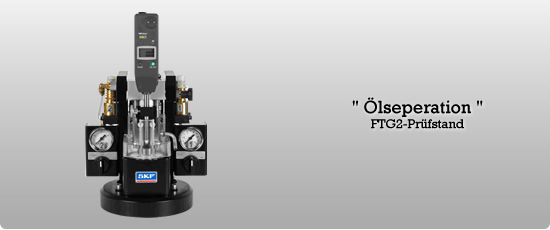The “FTG2” oil separation test rig

The FTG2 test rig can be used to investigate how a grease behaves under the action of pressure during long-term storage or in a lubrication system.
Normal tests for oil release (bleeding) are not sufficient for this specific issue.
The decisive parameter is the so-called oil separation. This refers to the unintentional separation of oil and thickener under the action of a pressure during storage and pumping. While oil separation in the bearings to be lubricated is desirable, it and the associated hardening of the grease can lead to malfunctions in the lubrication system and even to its failure.
To determine the risk of hardening, SKF developed the SKF FTG 2 test based on the “VOGEL-Marawe test”. It can be used to comparatively determine the hardening tendency of a grease under pressure in the laboratory.
The test is performed at 25 °C, 30 °C, 40 °C and 50 °C as standard. 2.5 cm³ of grease is required (2.5 ml).
The limit values used to evaluate the measurement results are empirical values. The results are displayed graphically. The graph shows at which temperature the lubricant is to be classified in which risk zone. This thus enables a statement to be made on the residual risk of lubricant hardening associated with the use of the grease and thus provides an objective basis for evaluation.